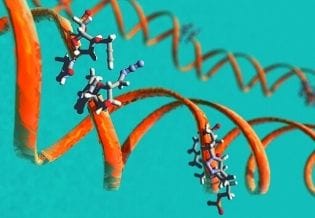About DNA and RNA Research
A premier international, peer-reviewed, open access platform dedicated to advancing molecular biology through the dissemination of transformative research on nucleic acid structure, function, regulation, and application.
JDRR welcomes original research articles, comprehensive reviews, short communications, case reports, technical notes, and opinion pieces that advance our understanding of nucleic acid biology. Our scope encompasses molecular mechanisms, structural biology, regulatory networks, and applied technologies related to DNA and RNA.
Higher-order chromatin architecture, DNA topology, replication fork dynamics, telomere biology, and mechanisms of DNA damage and repair pathways.
Transcriptional regulation, RNA polymerase mechanisms, co-transcriptional processing, splicing, polyadenylation, and RNA modifications.
Ribosome structure and function, mRNA-ribosome interactions, translation initiation/elongation/termination, and co-translational folding.
DNA methylation, histone modifications, chromatin remodeling complexes, nucleosome positioning, and epigenetic inheritance mechanisms.
Mutation mechanisms, DNA repair deficiencies, cancer genomics, genetic disorders, chromosomal aberrations, and therapeutic interventions.
microRNAs, long non-coding RNAs, circular RNAs, small interfering RNAs, RNA interference pathways, and post-transcriptional regulation.
Next-generation sequencing, single-cell genomics, RNA-seq methodologies, bioinformatics pipelines, and computational analysis tools.
CRISPR/Cas mechanisms, base editors, prime editors, delivery technologies, off-target effects, and therapeutic genome editing strategies.
Molecular diagnostics, mRNA therapeutics, gene therapy vectors, synthetic biology applications, and agricultural biotechnology innovations.
Ribozyme mechanisms, RNA folding pathways, RNA-protein interactions, aptamers, and structural determination methods.
JDRR offers a streamlined, author-focused publishing experience designed to accelerate the dissemination of high-quality nucleic acid research. Our editorial team comprises internationally recognized experts committed to fair, constructive, and timely peer review.
- Rigorous Peer Review: Expert evaluation ensures scientific validity, methodological rigor, and significance to the field.
- Rapid Publication Timeline: Efficient editorial processes deliver first decisions within weeks and publication within days of acceptance.
- Global Open Access: CC BY 4.0 licensing maximizes visibility and enables unrestricted sharing, translation, and adaptation with proper attribution.
- Broad Indexing: Articles are indexed in major databases, enhancing discoverability and citation potential.
- Interdisciplinary Community: JDRR connects molecular biologists, geneticists, computational scientists, and clinical researchers.
- Ethical Standards: Adherence to COPE guidelines and transparent editorial policies protect authors, reviewers, and readers.
- Flexible Article Types: Research papers, reviews, short communications, case reports, technical notes, and opinion pieces are welcome.
- Author Support: Comprehensive guidelines and responsive editorial assistance throughout the submission process.
JDRR has designed an intuitive submission workflow to minimize administrative burden while maintaining rigorous quality standards. Authors can choose from multiple submission pathways and receive clear communication at every stage.
Prepare your manuscript according to JDRR's author guidelines, including formatting requirements, reference style, figure specifications, and ethical documentation. Use our templates to ensure compliance.
Submit via our online portal, Manuscript Zone, or directly by email. Upload your manuscript file, figures, supplementary materials, and required documentation.
Your submission undergoes initial screening by the editorial team to assess scope alignment, scientific merit, and technical completeness before assignment to expert reviewers.
Independent experts evaluate your manuscript for originality, methodological rigor, data quality, and contribution to the field. Expect constructive, timely feedback through our rigorous peer review process.
Based on reviewer recommendations, you will receive a decision: acceptance, minor revisions, major revisions, or rejection. Detailed feedback guides any necessary revisions.
Accepted manuscripts undergo professional copyediting and formatting to ensure clarity, consistency, and adherence to journal style while preserving your scientific content.
Your article is published online with immediate open access, assigned a permanent DOI for citation, and submitted to indexing services for maximum discoverability.
JDRR articles are strategically indexed and archived to ensure long-term accessibility and citation visibility. Our content appears in major academic databases, search engines, and institutional repositories, connecting your research with relevant audiences.
Each published article receives a unique DOI through Crossref, facilitating accurate citation tracking and integration with reference management systems. JDRR also supports author self-archiving and institutional repository deposit to maximize research impact.
JDRR upholds the highest standards of publication ethics, guided by COPE principles and international best practices. We are committed to:
- Research Integrity: Originality verification, plagiarism screening, and data validation ensure authentic, trustworthy science.
- Ethical Compliance: All research involving human subjects, animals, or biohazards must document appropriate approvals and ethical oversight.
- Conflict of Interest Disclosure: Authors, reviewers, and editors must declare any potential conflicts that could influence objectivity.
- Authorship Transparency: Contributor roles must be clearly defined, and all listed authors must approve the final manuscript.
- Data Availability: We encourage data sharing and transparency to facilitate reproducibility and validation of published findings.
Advance Nucleic Acid Science with JDRR
Join a global community of researchers driving molecular biology forward. Submit your groundbreaking DNA and RNA discoveries to a journal that values rigor, speed, and open access.


